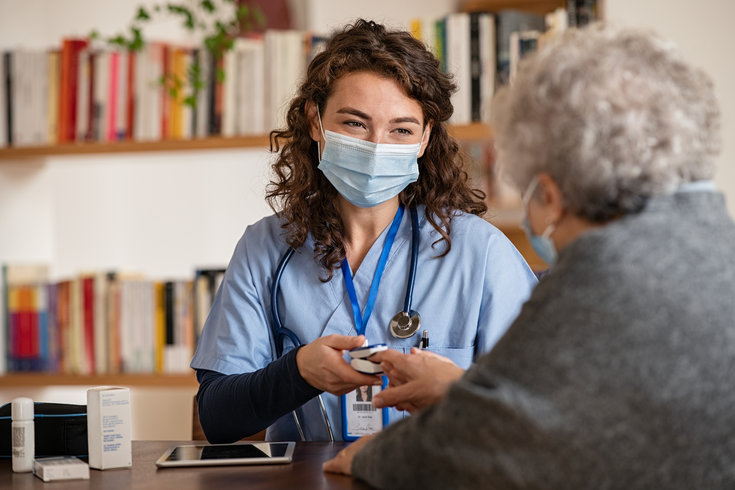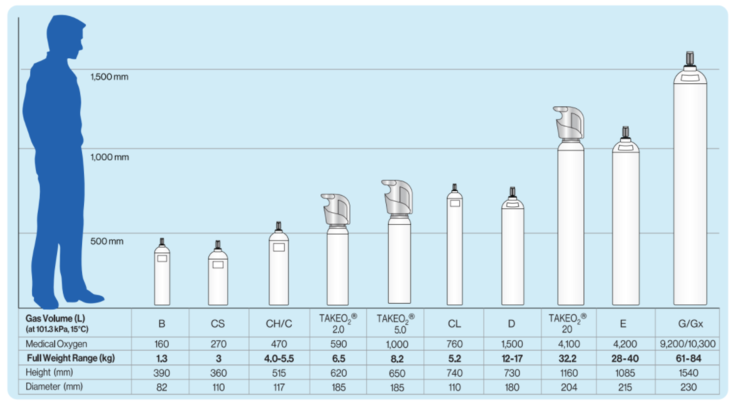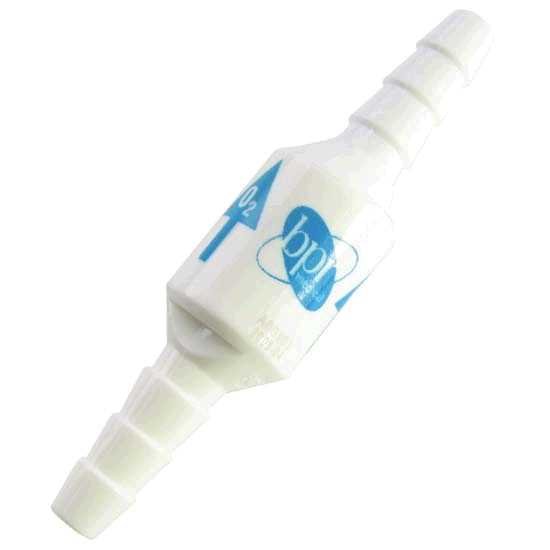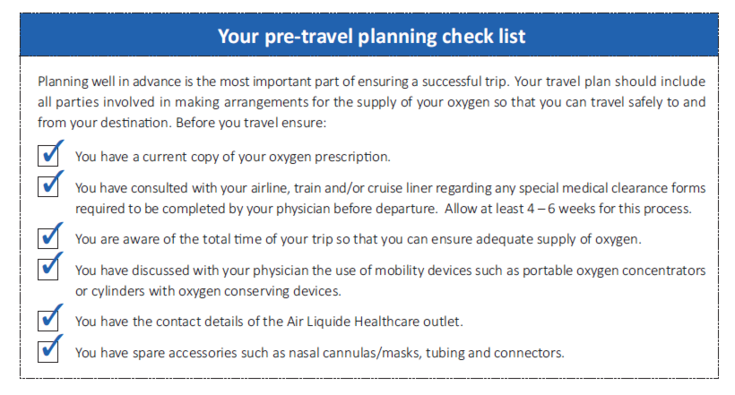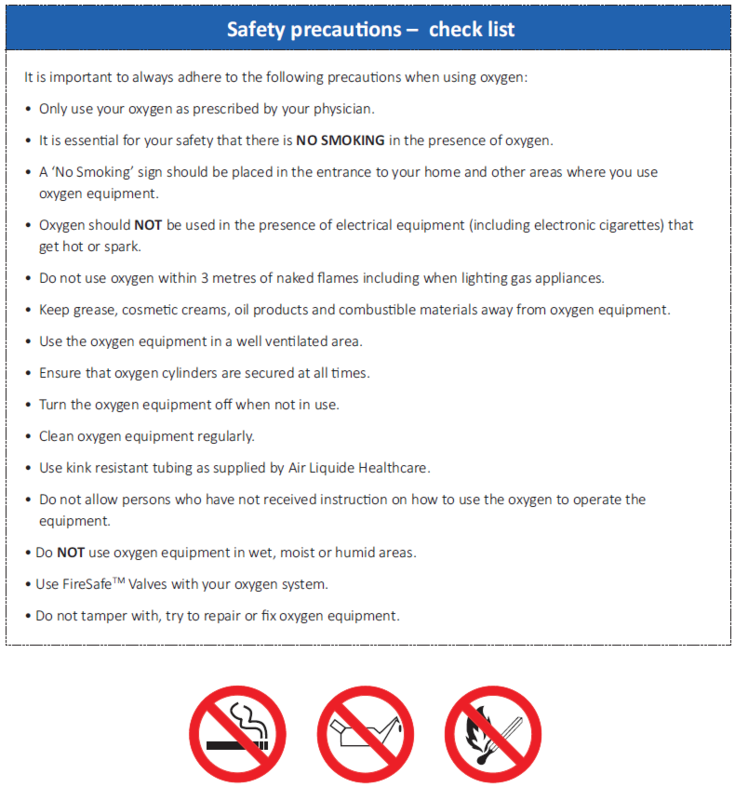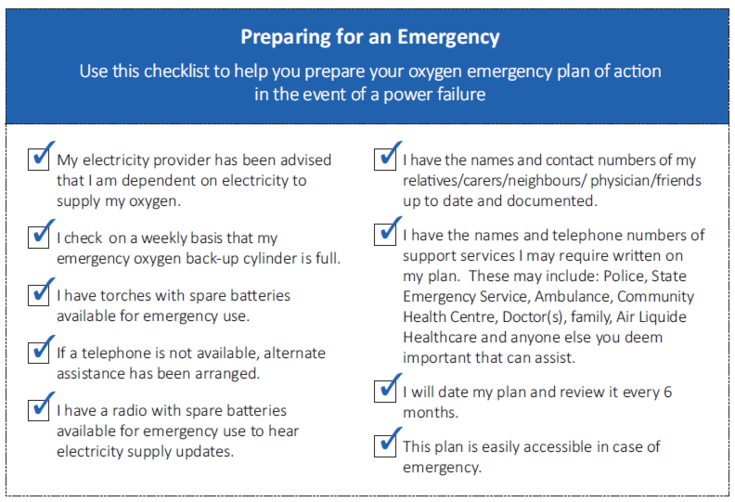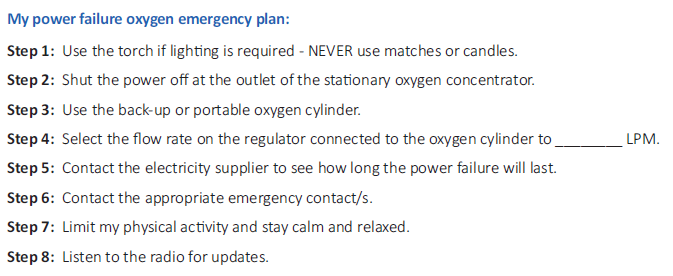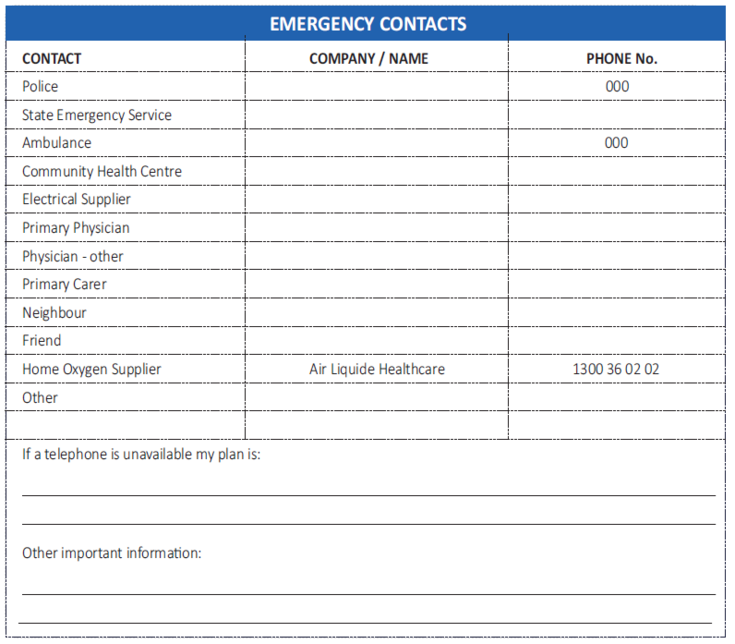Home Oxygen Therapy
Are you short of breath? We can help. Air Liquide Healthcare is Australia’s leading supplier of oxygen therapy services.
Why Oxygen Therapy?
Over time, your lung function decreases making it increasingly difficult for you to enjoy simple daily activities. To assist with your normal daily activities, your physician has prescribed home oxygen therapy.
Oxygen is essential for life.
Oxygen fuels your body’s organs and muscles allowing them to function and discard carbon dioxide.
The lungs make it possible for the blood to take in oxygen and eliminate carbon dioxide. When your lungs are damaged, the blood has difficulty taking in oxygen and getting rid of carbon dioxide.
This decrease in oxygen and increase of carbon dioxide in your blood can damage your body’s vital organs including your heart, kidneys, brain and muscles.
Your physician understands this and has requested Air Liquide Healthcare to provide you with home oxygen therapy.
Oxygen is a medicine.
Oxygen therapy increases the amount of oxygen in your blood to fuel your vital organs.
Oxygen is only beneficial when you are using it.
For most people, the benefits of using oxygen therapy include:
- Prolonged life 1,2
- Feeling less tired and less short of breath 1
- Increased ability to move about and exercise 1
- Increased sleep and quality of life 1
Why choose Air Liquide Healthcare?
Air Liquide Healthcare provides a variety of solutions to meet your medical oxygen needs today and in the future.
Our home oxygen services are performed in the comfort of your home by our highly skilled and qualified home healthcare technicians.
We encourage your family and friends to be involved in your therapy initiation and education on the safe use of oxygen therapy equipment.
We know that it can take some time to adjust to being on oxygen. you will receive our dedicated ‘inspiration’ oxygen newsletter filled with helpful tips on using your oxygen therapy every day.
Our customer service teams will schedule appointments in your home to make sure your equipment is functioning properly.
This is a great time for your family to be present so that you can build a strong support network.
Our knowledgeable customer service teams are only a phone call away.
We will assist with all aspects of your oxygen therapy including:
- Technical support over the phone
- Organising for a home healthcare technician to
- Provide support in the comfort of your home
- Assisting with arrangements for travelling with oxygen
An after-hours emergency equipment breakdown service is available for Air Liquide Healthcare owned rental concentrators.
We will assist with troubleshooting over the phone and organise a replacement for a faulty unit if required.
Frequently Asked Questions
How is the oxygen in my blood measured?
| Your physician will confirm if the amount of oxygen in your blood is low by performing one or both of the following tests: | |
|
Arterial Blood Gas: A small amount of blood is taken from an artery (usually in the wrist). this test is very accurate and measures the amount of oxygen and carbon dioxide in your blood. Pulse Oximetry: A pulse oximeter is a device with a sensor that attaches to your finger to estimate how saturated your blood is with oxygen. This test is simple and pain free and will verify whether your blood levels are too low. With your physicians’ approval, Air Liquide Healthcare can perform pulse oximetry testing in the comfort of your home. |
What does my oxygen prescription mean?
Our bodies cannot store oxygen.
Your physician has prescribed oxygen therapy adapted to meet your needs.
If you decrease the use of your oxygen, the benefits will be reduced or disappear.
Your physician will prescribe the:
- Flow rate: this is the amount of extra oxygen your body will need. Your physician may want your flow rate to always be the same or you may need to change the flow rate for different activities such as resting, sleeping or exercising. Your flow rate is expressed in litres per minute (Lpm).
- Duration of use: this refers to the number of hours per day in which you should use your oxygen therapy. usually, 16 - 24 hours of use per day is required for your therapy to be effective. Your physician will advise you of your needs.
- Type of oxygen supply equipment to use: Your physician will recommend different supply systems based on funding and what is available to enhance your lifestyle. Air Liquide Healthcare can assist you with your choice of equipment from our broad range of oxygen supply systems.
Oxygen therapy prescription examples:
1) Use oxygen for at least 16 hours per day at 2 litres per minute (Lpm)
OR
2) Use oxygen for 16 hours per day at:
- 3 Lpm when sleeping
- 2 Lpm when resting
- 3 Lpm on exertion
Contact your prescribing physician if you feel that the prescribed flow of oxygen is not meeting your needs.
What equipment is used to supply home oxygen therapy?
Your physician will decide whether you require oxygen at home and/or when you leave the house.
Air Liquide Healthcare will help you select the equipment that best suits your needs.
Oxygen can be provided through three main supply systems. These systems may be used alone or indifferent combinations.
Systems include:
- Stationary oxygen concentrators
- Portable oxygen concentrators
- Oxygen cylinder
Stationary Concentrator
An oxygen concentrator is an electrically driven device that extracts the oxygen from room air.
This means that the concentrator never runs out of oxygen and never needs to be refilled. Most stationary oxygen concentrators weigh anywhere between 18 – 30 kg and cannot be used outside of the home.
Stationary oxygen concentrators feature oxygen sensing devices that will warn you if the purity of the oxygen delivered decreases, so that you can use an alternative oxygen supply system and contact Air Liquide Healthcare for assistance.
Portable Concentrator
Portable oxygen concentrators (poc) operate in a similar way to stationary oxygen concentrators but are designed to be used while you are outside of the home. The weight of portable oxygen concentrators varies between models, ranging from 2 - 8kg. As a general rule, heavier pocs are capable of delivering higher oxygen flow rates. The battery duration for portable oxygen concentrators varies between models. Batteries are recharged from your mains power at home, and most have connections to recharge from your vehicle. Your poc should be serviced regularly to ensure that it is working properly and that the oxygen purity stays within the manufacturer’s recommendations. Since the amount of oxygen produced varies greatly between models, you will need to be tested on the specific device you intend to use to ensure that it will meet your oxygen needs.
What are oxygen cylinders?
Oxygen cylinders contain oxygen in gas form. they are filled under pressure to contain a greater volume of gas. The pressure is released with the use of a regulator which is also used to set the prescribed flow rate.
Cylinders can also be used with an oxygen conserving device which only delivers a flow of oxygen when you breathe in. your cylinder will last much longer since there is no oxygen flowing when you breathe out.
Oxygen cylinders are available in a variety of sizes and are separated into two main groups; portable and stationary.
Portable (small) cylinders are lightweight cylinders used outside of the home, and are available in a variety of sizes. Smaller models are contained in a bag which can be carried over your shoulder or used as a backpack.
The larger models can be transported using a trolley. Stationary (large) cylinders are normally used as a safety ‘back up’ for stationary oxygen concentrators in the event of power failure or equipment malfunction.
They are available in a variety of sizes. selection is based on your prescribed flow rate and how far away you live from an Air Liquide Healthcare office.
What accessories do I need with my oxygen therapy?
Oxygen is typically delivered from the supply system to your nose with a ‘cannula’. extension tubes are available in a variety of lengths (up to 15 metres) to allow you to move about the house while connected to your oxygen supply system. Both the cannula and the extension
tubing are available in a variety of sizes and lengths. Based on your prescription, Air Liquide Healthcare will assist you in choosing accessories.
Firesafe cannula valves* can be connected to your oxygen accessories to provide an extra line of defence, that can limit the impact of an oxygen fire by automatically arresting the oxygen flow in the event of a fire.
Other specialty accessories are available as prescribed by your physician.
How often do I replace my oxygen accessories?
Your cannula will become dirty and brittle with use and may hurt your ears and skin if not replaced at least once to twice a month.
Extension tubing is disposable and should be replaced every three to six months to ensure that no leaks occur.
The firesafe valve is typically replaced every six months.
How do I use oxygen in my everyday life?
Integrating oxygen therapy into your daily routine will not only prolong your life but enhance your quality of life 1,2
Remember that the objective of using oxygen therapy is to increase the amount of oxygen in your blood, supplying enough to all organs during rest and during physical activities.
Use your oxygen as prescribed while you go about your normal routine such as running errands, doing housework, watching television or reading a book. It is important to use your oxygen even when outside of the home.
Use oxygen as prescribed in your everyday life, when:
What can I do if my ears or nose are sore?
If your nose becomes dry or sore you can use a product such as Nozoil, which is safe to use with oxygen therapy. You should never use any petroleum based products (such as creams and oils) with oxygen.
If your ears are sore, you may want to try a product such as eZ Wraps - soft foam tubes that fit over the cannula. They provide a soft cushioning for the sensitive tissue around your ears.
If you are experiencing discomfort from your oxygen therapy contact Air Liquide Healthcare for assistance.
Learn More - About our range of oxygen consumables
Shop Now - Visit our online store to purchase these products
Are there any support groups for people on oxygen therapy?
Support groups offer an opportunity to network, learn and share skills to help in a range of issues associated with health problems such as feeling low, irritability, isolation and confusion. There is also a strong focus on how to stay healthy and active.
There are a variety of established support groups including support from your area health service and Lung foundation Australia. for information on a lung support group nearest you, please contact your local healthcare facility or Lung foundation Australia:
http://lungfoundation.com.au/patient-area/patientsupport/
Downloadable Resources
-
Home Oxygen Solutions
Download the document PDF (7.54 MB)
Resources
Pre-Travel planning checklist
General Oxygen Safety
Power Failure Emergency Planning Checklist
Emergency Contact List
1) continuous or Nocturnal oxygen therapy in Hypoxemic chronic obstructive Lung disease: A clinical trial in Annals of internal medicine, 1980; 93(3): 391 – 398; *funding details unavailable for 1980.
2) Report from the medical Research council Working party. Long term domiciliary oxygen therapy in chronic Hypoxic cor pulmonale complicating chronic bronchitis And emphysema in the Lancet, volume 317, No. 8222, 681 – 686, march 1980; *funding details unavailable for 1981.



